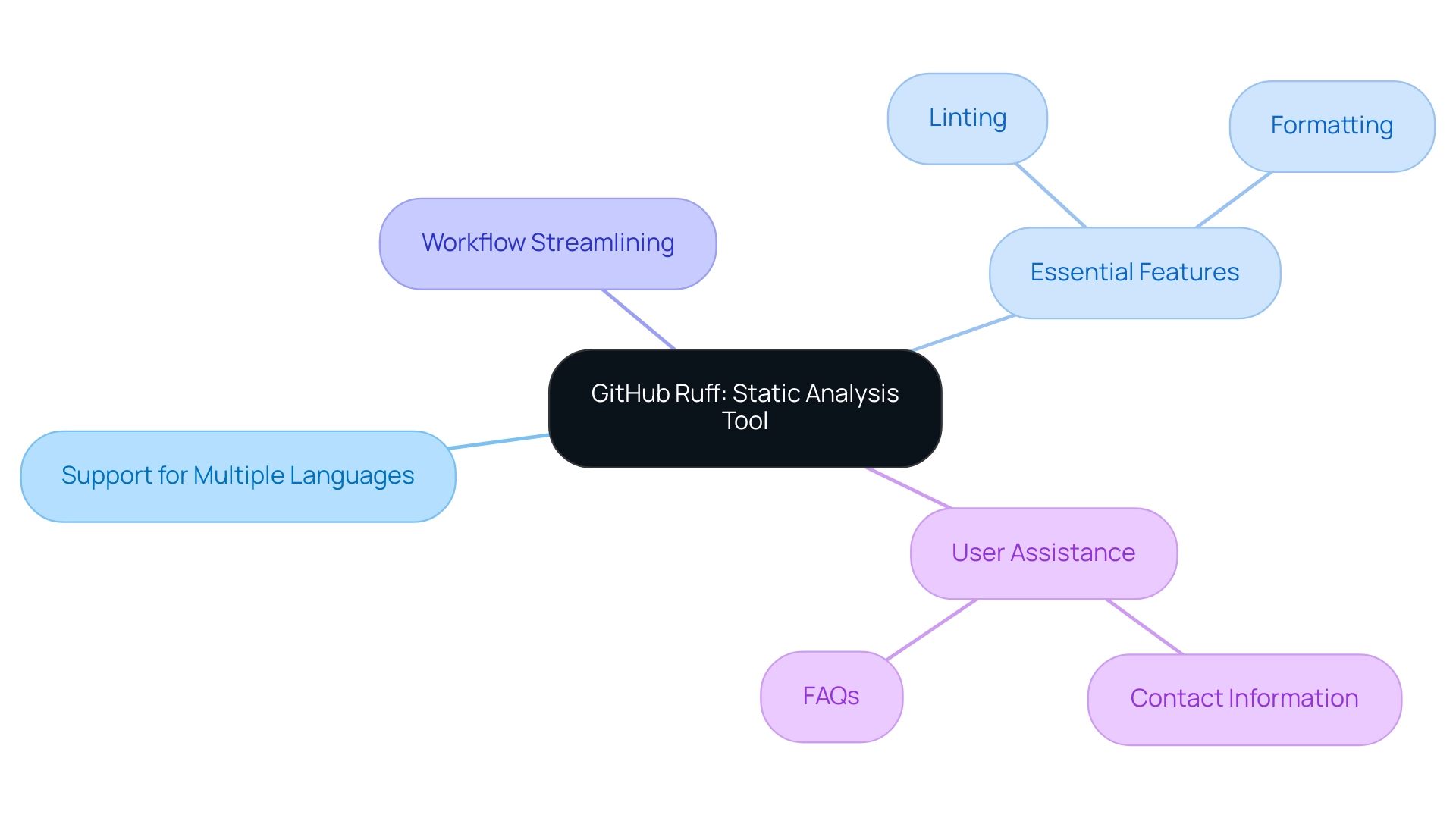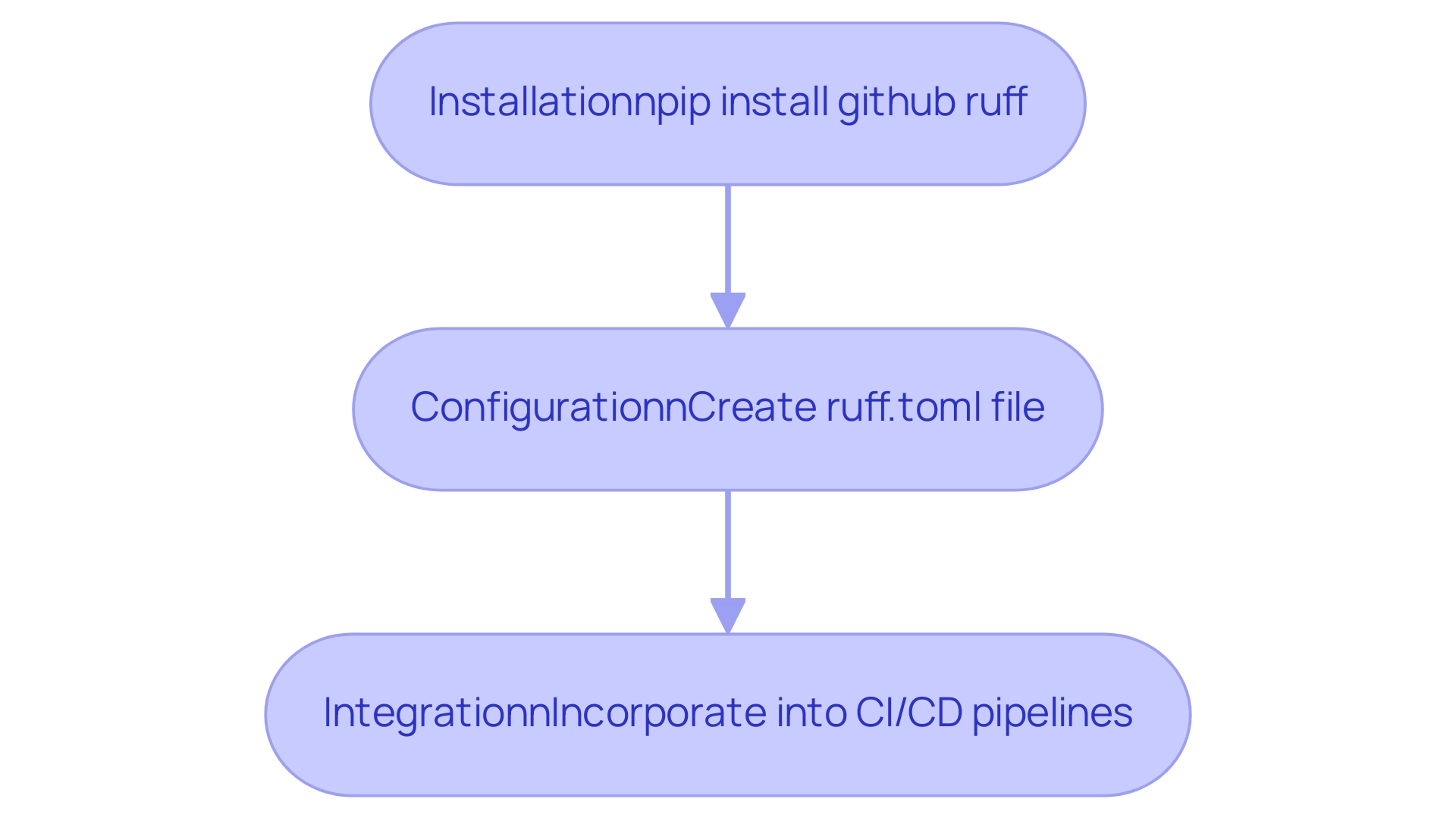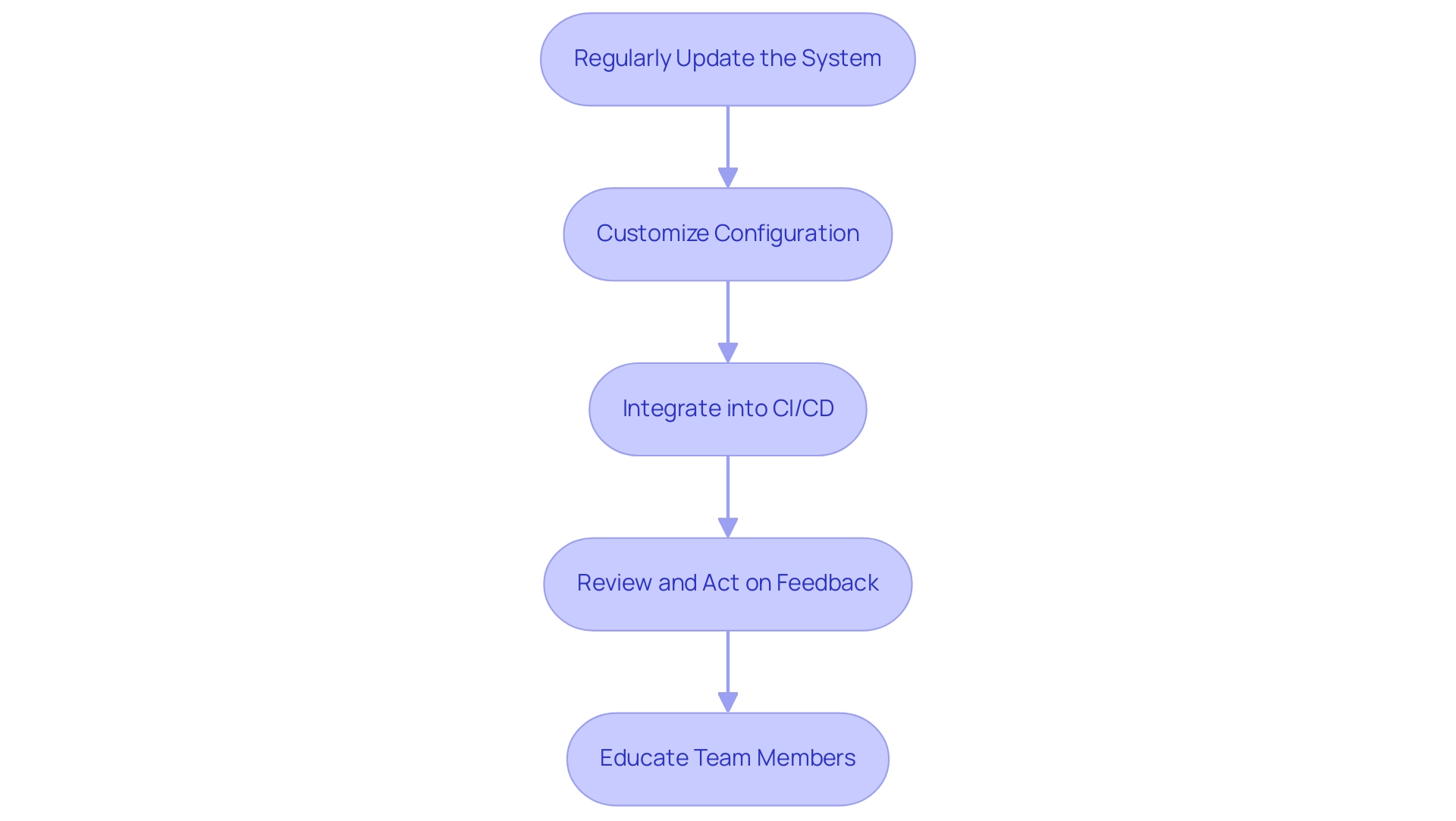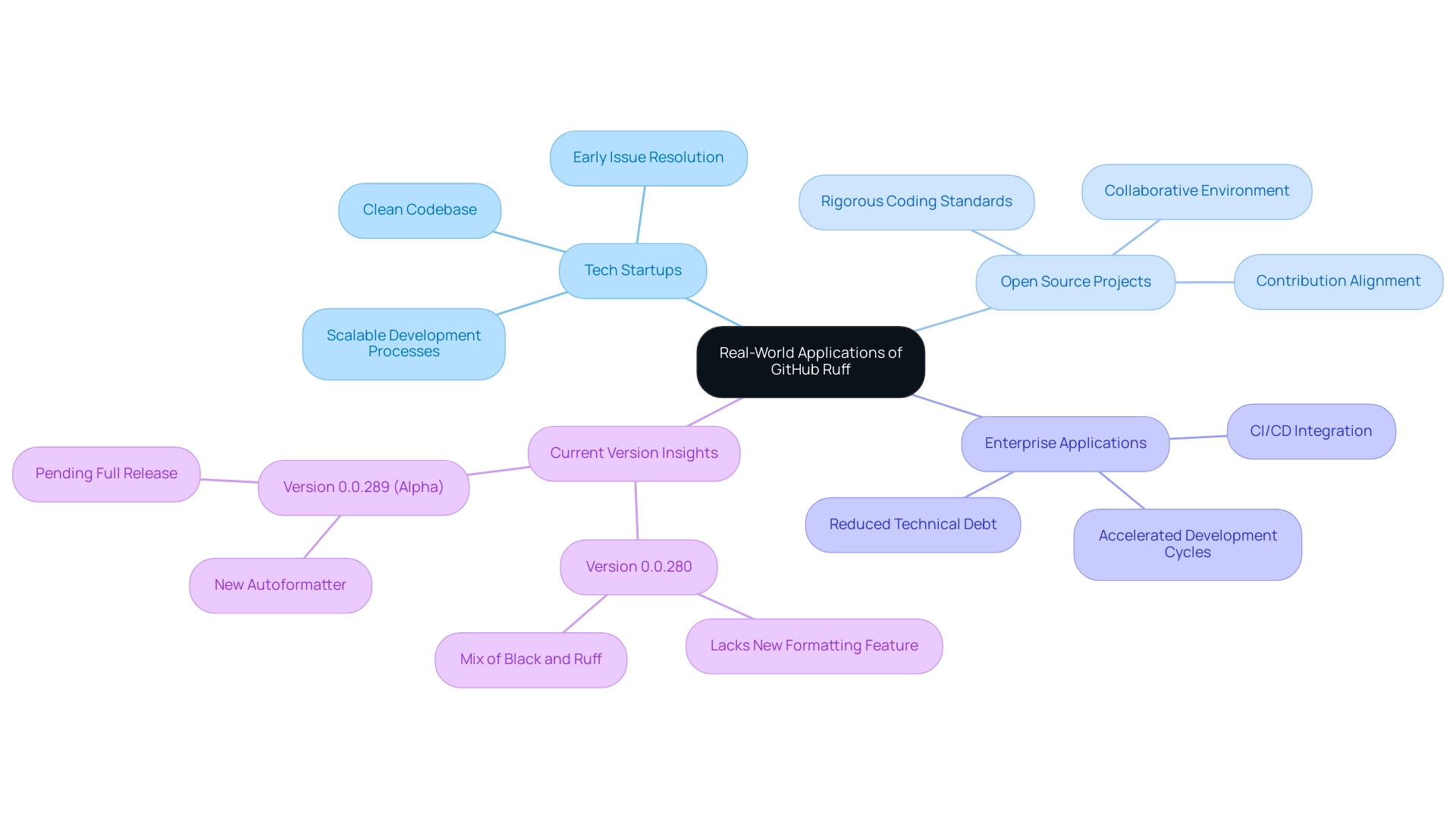Introduction
In the ever-evolving landscape of software development, maintaining high code quality is more critical than ever. GitHub Ruff stands out as a powerful static analysis tool designed to help developers streamline their coding practices and enhance efficiency. By enabling early detection of potential issues, Ruff empowers teams to tackle errors before they escalate, ensuring a smoother development process.
Its robust features, including:
- Multi-language support
- Linting
- Customizable rules
make it an essential asset for any coding project. When paired with Kodezi CLI, developers can automate debugging and optimize performance, creating a seamless workflow that promotes collaboration and adherence to best practices.
As organizations strive for excellence in their codebases, embracing tools like GitHub Ruff becomes vital for achieving maximum productivity and security in software development.
Introduction to GitHub Ruff: A Static Analysis Tool
GitHub Ruff is a cutting-edge static analysis tool designed for developers looking to enhance software quality and efficiency. It assesses source material without execution, enabling teams to identify potential issues early, thus preventing errors from escalating. Key benefits of using GitHub include:
- Support for multiple programming languages
- Essential features like linting and formatting
- Ability to streamline the development workflow
Furthermore, Kodezi CLI enhances the tool by automating debugging tasks, allowing programmers to view detailed explanations and insights into what went wrong and how it was resolved, while also addressing performance bottlenecks and enforcing security best practices. This ensures your codebase adheres to the latest standards. By integrating tools like Kodezi into their daily routines, teams can greatly enhance collaboration, maintainability, and software excellence, resulting in a smoother release process.
For user assistance, contact information and FAQs are readily available, ensuring programmers have the support they need. In today's fast-paced environment, adopting a proactive approach to code quality with GitHub Ruff and Kodezi is essential for maximizing productivity in software development. Get started for free or request a demo today to elevate your coding skills and ensure your codebase follows the latest security best practices!

Setting Up GitHub Ruff: Installation and Configuration
Getting started with GitHub is straightforward, allowing developers to enhance their coding efficiency through effective installation and configuration:
- Installation: GitHub Ruff's tool can be easily installed using package managers like
pipfor Python users or directly from the GitHub repository. For instance, executingpip install github ruffwill promptly install the latest version of the tool on your local machine, ensuring you have the most recent features and fixes. - Configuration: Post-installation, a configuration file named
ruff.tomlshould be created in the root directory of your project. This file is essential as it allows programmers to customize the functionality, determining which rules to enforce, specifying files or directories to ignore, and defining specific preferences that align with the project's objectives. - Integration: To fully leverage the capabilities of GitHub Ruff, integrating it into CI/CD pipelines is essential. This integration ensures that the program undergoes automatic analysis with each commit, facilitating prompt feedback to programmers and maintaining strict quality standards. As Andrew Park, VP of Engineering at G3, emphasizes,
Creating, testing, and implementing patches to operational systems typically incurs significantly greater expenses than executing it correctly from the outset.
Furthermore, static analysis tools can assist in avoiding programming defects early in the development phase, lowering the likelihood of facing more costly issues later on.
Nonetheless, programmers should also recognize the difficulties linked to static analysis, such as the production of false positives and negatives. Balancing the reduction of these inaccuracies while maintaining detection accuracy is a significant challenge for SAST tools. Thus, it is essential for programmers to concentrate on productivity when incorporating static analysis, ensuring they are not inundated by alerts and can effectively employ tools to improve their review processes and guarantee adherence to programming standards.

Key Features of GitHub Ruff
GitHub's tool is equipped with several essential features that significantly improve programmer efficiency and software excellence:
- Linting: The application excels in comprehensive linting capabilities, identifying syntax errors, stylistic inconsistencies, and potential bugs, thereby ensuring compliance with coding standards. This proactive approach minimizes the risk of errors before they escalate into larger issues. As noted, running the lint tool as a Git hook ensures that programmers who push their changes will discover any linter errors at commit/push time instead of as a result of a failed CI pipeline.
- Formatting: By automating formatting according to established style guidelines, the tool fosters uniformity across the codebase, which not only enhances readability but also streamlines collaboration among team members.
- Performance Metrics: The tool delivers valuable insights into performance, highlighting bottlenecks and enabling programmers to optimize resource usage effectively. This data-driven approach supports informed decision-making and enhances overall efficiency.
- Customizable Rules: The tool allows users to adjust linting guidelines and configurations to meet specific project requirements, providing the flexibility necessary for diverse development environments while maintaining high programming standards.
- Integration with Editors: Its seamless integration with popular text editors ensures that programmers receive real-time feedback as they write, facilitating the early detection of issues and promoting a more efficient development process.
In addition to the tool's features, Kodezi CLI enhances the pre-push assurance process by automating debugging and optimizing performance, security, and adherence to coding standards in seconds. Kodezi CLI's automated debugging enhances the linting features of GitHub Ruff by enabling programmers to not only pinpoint linting problems but also resolve them quickly, ensuring that only strong software is pushed to the repository. Together, these tools collaboratively enable developers to create cleaner, more efficient programming, resulting in improved software standards and maintainability.
Furthermore, recent statistics indicate that scores across 45 applicable models were 22.9% higher with static repair, reinforcing the necessity of robust linting and formatting practices in modern software development. This emphasizes the efficiency of combining Kodezi CLI with GitHub Ruff, as both tools work together to enhance programming standards and ensure security adherence. Moreover, the Sonar suite, which features tools such as SonarLint and SonarQube, illustrates the effectiveness of linting tools in identifying programming issues and security vulnerabilities, further highlighting the significance of incorporating such tools into the development process.
Best Practices for Using GitHub Ruff
Maximizing the advantages of GitHub requires adherence to several best practices that enhance both quality and team productivity:
- Regularly Update the System: Keeping the system updated ensures access to the latest features and enhancements, which are essential for maintaining cutting-edge coding standards.
- Customize Configuration: Adjust the
ruff.tomlconfiguration file to meet the specific needs of your project, utilizing github ruff to align the analysis with your team’s coding standards for optimal results. - Integrate into CI/CD: By embedding this tool into your continuous integration and continuous deployment pipelines, you can automate analysis and uphold high standards consistently, reducing manual oversight.
- Review and Act on Feedback: Regularly evaluate the feedback received and implement necessary changes. This proactive approach fosters a culture of quality, ensuring that issues are addressed swiftly.
- Educate Team Members: Sharing knowledge about Ruff’s features and best practices among team members empowers everyone to utilize its capabilities effectively, thereby creating a more productive development environment.
Implementing these best practices not only leverages the full potential of GitHub Ruff but also results in cleaner, more efficient, and maintainable programming. As Adnane Arharbi states,
By incorporating static analysis into the development process, teams can detect issues early, avoid common security pitfalls, and maintain high coding standards.
This highlights the transformative effect of adopting robust analysis tools.
Furthermore, static analysis is acknowledged as a powerful technique for enhancing quality, security, and maintainability, enabling teams to detect issues early and uphold high programming standards. Emerging trends indicate a shift towards the use of AI and machine learning in static analysis, enhancing vulnerability detection and improving the developer experience. Furthermore, studies indicate that teams employing analysis tools can experience a productivity boost of up to 30%, emphasizing the significance of incorporating these best practices into your development workflow.

Real-World Applications of GitHub Ruff
The implementation of GitHub Ruff across diverse organizations has led to notable enhancements in code quality and overall development efficiency:
- Tech Startups: Numerous tech startups have integrated Ruff into their workflows to optimize development processes. By identifying and resolving issues early, they maintain a clean codebase that scales effectively with their growth.
- Open Source Projects: Contributors in the open source community utilize github ruff as a tool to uphold rigorous coding standards. This ensures that all contributions align with the project's standards before they are merged, fostering a healthy collaborative environment.
- Enterprise Applications: Large enterprises have successfully incorporated this tool, github ruff, into their continuous integration and continuous deployment (CI/CD) pipelines. This proactive approach not only accelerates development cycles but also significantly reduces technical debt by addressing potential code quality issues before they escalate.
As noted by Sukanya Pai, "It seems like the tool has released Python Formatter as part of v0.0.289 and is currently in alpha state." However, many users are still utilizing version 0.0.280, which does not include this new formatting feature. Until the autoformatter is completely accessible, users are presently depending on a mix of Black and another tool to satisfy their project needs.
These diverse applications underscore the versatility of GitHub Ruff and its capability to cater to the unique needs of different project types. As a result, it emerges as an indispensable tool for development teams aiming to enhance their code quality and productivity.

Conclusion
Incorporating GitHub Ruff into the software development workflow serves as a game-changer for teams striving to enhance code quality and efficiency. With its ability to conduct early static analysis across multiple programming languages, Ruff empowers developers to identify and resolve potential issues before they escalate, ultimately fostering a smoother and more productive development process.
The tool's robust features—such as comprehensive linting, customizable rules, and seamless integration with popular code editors—make it an essential asset for maintaining coding standards and optimizing performance. When combined with Kodezi CLI, the overall effectiveness of code quality assurance is amplified, allowing for automated debugging and enhanced collaboration among team members.
Embracing best practices, such as regular updates and thoughtful integration into CI/CD pipelines, ensures that the benefits of GitHub Ruff are fully realized. Organizations across various sectors have already witnessed significant improvements in maintainability and overall development efficiency by adopting Ruff, highlighting its versatility and effectiveness in promoting high coding standards.
As the landscape of software development continues to evolve, leveraging tools like GitHub Ruff is no longer a luxury but a necessity for teams aiming for excellence. By prioritizing proactive code quality measures, developers can not only enhance their productivity but also contribute to creating secure, high-quality software that meets the demands of today's fast-paced environment.
Frequently Asked Questions
What is GitHub Ruff?
GitHub Ruff is a static analysis tool designed for developers to enhance software quality and efficiency by assessing source material without execution, helping teams identify potential issues early.
What are the key benefits of using GitHub Ruff?
Key benefits include support for multiple programming languages, essential features like linting and formatting, and the ability to streamline the development workflow.
How does Kodezi CLI enhance GitHub Ruff?
Kodezi CLI automates debugging tasks, provides detailed explanations of issues, addresses performance bottlenecks, and enforces security best practices, ensuring adherence to the latest coding standards.
How can developers get started with GitHub Ruff?
Developers can easily install GitHub Ruff using package managers like pip, create a configuration file named ruff.toml for customization, and integrate it into CI/CD pipelines for automatic analysis with each commit.
What essential features does GitHub Ruff offer?
Essential features include comprehensive linting to identify errors and inconsistencies, automated formatting for coding uniformity, performance metrics for optimization, customizable rules, and integration with popular text editors for real-time feedback.
What best practices should be followed when using GitHub Ruff?
Best practices include regularly updating the system, customizing the configuration, integrating into CI/CD, reviewing and acting on feedback, and educating team members about Ruff’s features.
How has GitHub Ruff been implemented in various organizations?
Tech startups use Ruff to maintain clean codebases, open source projects uphold coding standards, and large enterprises integrate it into CI/CD pipelines to accelerate development and reduce technical debt.
What challenges are associated with static analysis tools like GitHub Ruff?
Challenges include the production of false positives and negatives, which can overwhelm programmers with alerts. Balancing detection accuracy while minimizing inaccuracies is crucial for effective use.




